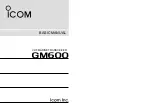
XNX Universal Transmitter
Introduction
12
20 mA/HART Output
All XNX Transmitters provide a 20mA Current Loop with HART
Communication which can be user configured for Sink, Source
(3-Wire) or Isolated (4-Wire) electrical interface based on
installation requirements.
The 20mA current loop output provides an analog indication of
special states, a proportional output to gas concentration and
overrange indication as shown in the table below. In the event of
a simultaneous alarm and fault, an alarm condition will always
override fault or warning state.
Output
Description*
Notes
1.0 mA
Fault
Special
State
Indication
2.0 mA
Warm-up
Inhibit
Bump Test
Calibration
3.0 mA
Warning
4-20 mA
Gas Concentration
21 mA
Overrange
*Alarm conditions always take priority over faults and warnings.
HART Protocol provides communications with the transmitter
from a remote control system for Configuration, Status, and
Diagnostics. (See the
section for additional
information)
Communications
The XNX
®
Universal Transmitter is registered with the HART
®
Communication Foundation. The transmitter
features HART over 4-20mA as standard.
Additional optional communication interfaces are available:
relay communication, Modbus, or FOUNDATION Fieldbus.
Each communication option has a dedicated option board. For
additional information, refer to the
section.
Certifications
XNX-UT**-****** Versions are UL and CSA listed for installation in
Class I, Division 1, Groups A, B, C and D Hazardous Locations.
FM Approvals evaluation includes Class I, Zone 1, Group IIC,
as well as performance tests for specific sensor/transmitter
combinations. The
CSA or FM certification does not cover daisy-
chained XNX combustible gas transmitters, the use of HART,
Modbus, or FOUNDATION Fieldbus protocols for combustible
gas performance. HART, Modbus, or FOUNDATION Fieldbus
protocols can be used only for data collection or record keeping
with regards to combustible gas. The EC cartridge
2
and EC
remote mount kit are UL classified to Canandian and US
standards.
XNX-AM **-***** versions are certified to comply with the
European Community
ATEX Directive and the prescribed
protection methods for installation in potentially explosive
atmospheres.
XNX-BT**-***** versions are UL listed and INMETRO approved for
compliance with both U.S. and Brazilian standards.
See the
section for additional information on
applicable approvals by part number and the
Storage Conditions for Performance Tested EC Sensors
section
for marking.
2
“Cartridge” and “sensor” are used interchangeably in this document.
Summary of Contents for XNX-AM Series
Page 2: ...This page is intentionally left blank ...
Page 7: ...XNX Universal Transmitter Safety and Information 5 Safety and Information ...
Page 12: ...XNX Universal Transmitter XNX Universal Transmitter Technical Manual 10 Introduction ...
Page 27: ...XNX Universal Transmitter Introduction 25 Menu Navigation ...
Page 102: ...XNX Universal Transmitter XNX Universal Transmitter Technical Manual 100 Calibration ...
Page 118: ...XNX Universal Transmitter XNX Universal Transmitter Technical Manual 116 Maintenance ...
Page 122: ...XNX Universal Transmitter XNX Universal Transmitter Technical Manual 120 Warnings and Faults ...
Page 139: ...XNX Universal Transmitter XNX Universal Transmitter Technical Manual 137 Specifications ...
Page 174: ...XNX Universal Transmitter XNX Universal Transmitter Technical Manual 172 Control Drawings ...
Page 177: ...XNX Universal Transmitter Control Drawings 175 ...
Page 179: ...XNX Universal Transmitter Control Drawings 177 Remote Sensor Mount ...
Page 180: ...XNX Universal Transmitter XNX Universal Transmitter Technical Manual 178 HART Protocol ...
Page 193: ...XNX Universal Transmitter XNX Universal Transmitter Technical Manual 191 Modbus Protocol ...
Page 200: ...XNX Universal Transmitter XNX Universal Transmitter Technical Manual 198 Warranty ...
Page 202: ...XNX Universal Transmitter XNX Universal Transmitter Technical Manual 200 Index ...














































